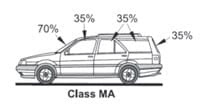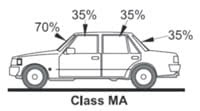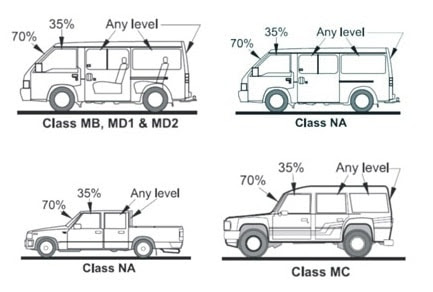Home > Product > TINTING LAWS NZ
In New Zealand, the application of window tinting in vehicles is subject to certain legal requirements. These restrictions, outlined in the Land Transport Rule: Glazing, Windscreen Wipe and Wash, and Mirrors Rule 1999(opens in a new tab), intend to ensure driver visibility and structural safety of the glazing material.
Always ensure your window tint is legal and double-check the most recent window tint laws in New Zealand.
The New Zealand window tinting laws stipulate:
Class MA is a passenger car.


Vans, 4WDs and SUVs can have any degree of dark tint behind the driver's door.

Along with the window tint regulations, there are other related rules to observe:
Q: What is VLT? VLT stands for Visible Light Transmission, which measures the percentage of light that can pass through a window. A higher VLT means more light passes through, and the window is less tinted.
Q: Are there penalties for exceeding the legal tint limit? Yes, penalties can range from fines to having your vehicle deemed non-roadworthy.
Q: Can I have different tint levels on different windows? Yes, the level of tint allowed varies depending on the window. Front side windows and rear windows in class MA vehicles must have an overall VLT of at least 35%. Other vehicles have different regulations.
Q: Can the factory-made tint on new vehicles be darker than the stated laws? No, the window tint laws apply to all vehicles, regardless of how they were manufactured.
Waka Kotahi NZ Transport Agency - Vehicle windows, wipers and mirrors
In New Zealand, the application of window tinting in vehicles is subject to certain legal requirements. These restrictions, outlined in the Land Transport Rule: Glazing, Windscreen Wipe and Wash, and Mirrors Rule 1999(opens in a new tab), intend to ensure driver visibility and structural safety of the glazing material.
Always ensure your window tint is legal and double-check the most recent window tint laws in New Zealand.
The New Zealand window tinting laws stipulate:
Class MA is a passenger car.


Vans, 4WDs and SUVs can have any degree of dark tint behind the driver's door.

Along with the window tint regulations, there are other related rules to observe:
Q: What is VLT? VLT stands for Visible Light Transmission, which measures the percentage of light that can pass through a window. A higher VLT means more light passes through, and the window is less tinted.
Q: Are there penalties for exceeding the legal tint limit? Yes, penalties can range from fines to having your vehicle deemed non-roadworthy.
Q: Can I have different tint levels on different windows? Yes, the level of tint allowed varies depending on the window. Front side windows and rear windows in class MA vehicles must have an overall VLT of at least 35%. Other vehicles have different regulations.
Q: Can the factory-made tint on new vehicles be darker than the stated laws? No, the window tint laws apply to all vehicles, regardless of how they were manufactured.
Waka Kotahi NZ Transport Agency - Vehicle windows, wipers and mirrors